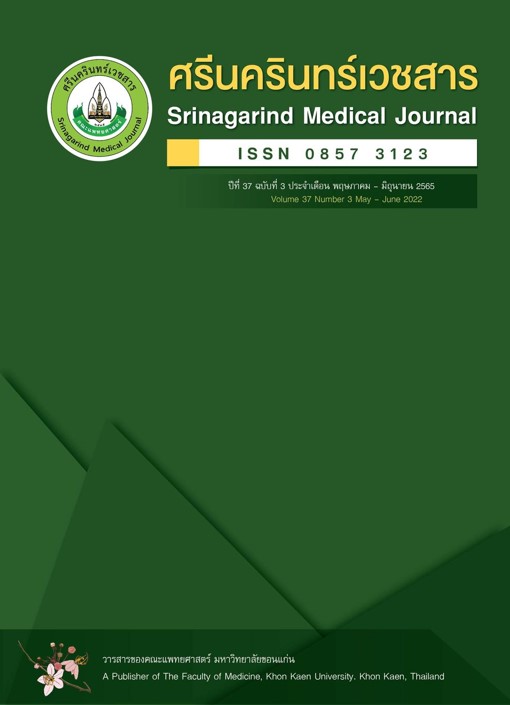การรับรู้ของผู้ป่วยเกี่ยวกับภาวะแทรกซ้อนและการปฏิบัติตัวเมื่อได้รับการระงับความรู้สึกทางช่องไขสันหลังในโรงพยาบาลสงขลานครินทร์
คำสำคัญ:
Patient perception, Behavior, Complications, Spinal anesthesiaบทคัดย่อ
หลักการและวัตถุประสงค์: การระงับความรู้สึกทางช่องไขสันหลังทำให้ผู้ป่วยมีความวิตกกังวล เนื่องจากบริเวณลำตัวช่วงล่างมีอาการชา ขยับไม่ได้ บางรายมีภาวะแทรกซ้อนร่วมด้วย เรื่องของการรับรู้เกี่ยวกับภาวะแทรกซ้อนยังไม่เคยมีการศึกษามาก่อน การศึกษานี้มีวัตถุประสงค์เพื่อศึกษาระดับการรับรู้ของผู้ป่วยเกี่ยวกับภาวะแทรกซ้อนและการปฏิบัติตัวเมื่อได้รับการระงับความรู้สึกทางช่องไขสันหลัง
วิธีการศึกษา: เป็นการศึกษาเชิงพรรณนา ประชากรเป็นผู้ป่วยที่เข้ารับการผ่าตัดแบบไม่เร่งด่วนและได้รับยาระงับความรู้สึกทางช่องน้ำไขสันหลังในโรงพยาบาลสงขลานครินทร์เดือนมี.ค. 2564- ม.ค. 2565 จำนวน 410 ราย เครื่องมือที่ใช้ในการศึกษาคือ แบบสอบถามข้อมูลส่วนบุคคล ระดับคะแนนการรับรู้ในการปฏิบัติตัวและภาวะแทรกซ้อน เกณฑ์การให้คะแนน 5 ระดับ ตรวจหาความน่าเชื่อถือของเครื่องมือโดยวิธีครอนบาคอัลฟ่า ค่าความน่าเชื่อถือที่ 0.93
ผลการศึกษา: คะแนนเฉลี่ยการรับรู้การปฏิบัติตัวของผู้ป่วยอยู่ในระดับดีมาก (4.51 ± 1.00) การปฏิบัติตัวที่มีคะแนนการรับรู้สูงสุดคือการงดน้ำและอาหารอย่างน้อย 8 ชั่วโมงก่อนทำหัตถการ (4.86 ± 0.45) การปฏิบัติตัวที่มีคะแนนการรับรู้ต่ำสุดคือ การห้ามวางของร้อนหรือสัมผัสของมีคมบริเวณร่างกายที่ชา (3.89 ± 1.37) การรับรู้ภาวะแทรกซ้อนมีคะแนนการรับรู้เฉลี่ยอยู่ในระดับดี (4.43 ± 1.08) คะแนนการรับรู้สูงสุดคือทราบว่าเมื่อมีอาการปวดสามารถขอยาแก้ปวดได้ (4.81 ± 0.64) คะแนนการรับรู้ต่ำคือทราบว่าอาจเกิดอาการหนาวสั่น (4.14 ± 1.22)
สรุป: การรับรู้ของผู้ป่วยเกี่ยวกับภาวะแทรกซ้อนและการปฏิบัติตัวเมื่อได้รับการระงับความรู้สึกทางช่องไขสันหลังในภาพรวมมีระดับสูง การรับรู้การปฏิบัติตัวหลังผ่าตัดเรื่องห้ามวางของร้อนหรือสัมผัสของมีคมบริเวณที่ชาและการรับรู้ภาวะแทรกซ้อนขณะอยู่ในห้องผ่าตัดเรื่องอาจมีอาการหนาวสั่นมีคะแนนน้อยที่สุด
เอกสารอ้างอิง
Nimmaanrat S. Spinal anesthesia. [Cited October 10, 2563]. Available from: http://medinfo2.psu.ac.th/anesth/education/spinal.html
Macfarlane A JR, Brull R, Chan VWS. Spinal epidural and caudal anesthesia. In: Pardo M Jr, Miller RD, editors. Basic of Anesthesia. 7th ed. Philadelphia: Elsevier, 2018:280-300.
Department of Anesthesiology Faculty of Medicine Prince of Songkla University. Annual Report and Statistical Data Analysis Volume 23. Songkla: Department; 2017. [Cited October 10, 2563]. Available from: https://anes.medicine.psu.ac.th/annualreport
Department of Anesthesiology Faculty of Medicine Prince of Songkla University. Annual Report and Statistical Data Analysis Volume 24. Songkla: Department; 2018. [Cited October 10, 2563]. Available from: https://anes.medicine.psu.ac.th/annualreport
Department of Anesthesiology Faculty of Medicine Prince of Songkla University. Annual Report and Statistical Data Analysis Volume 25. Songkla: Department; 2019. [Cited October 10, 2563]. Available from: https://anes.medicine.psu.ac.th/annualreport
Marshall SI, Chung F. Discharge criteria and complications after ambulatory surgery. AnesthAnalg 1999; 88(3):508-17.
Gerlach RM , Sweitzer BJ. Preoperative evaluation and medication. In: Pardo M Jr, Miller RD, editors. Basics of Anesthesia. 7th ed. Philadelphia: Elsevier, 2018:189-212.
Poomhirun P, Ongvisetpaiboon W, Arnuntasupakul V. A Study of Patients’ Knowledge in Self-Care Undergoing Neuraxial Block. RNJ 2018; 24:69-79.
Srisatidnarakul B. The Methodology in Nursing Research. Bangkok: U & I Inter Media; 2010.
Srisa-Ard B. Introduction to Research. 10th ed. Bangkok: Suweerivasarn: 2017.
Hongvilai K. The Outcomes of Readiness Pattern for Patients Undergone Anesthesia [Dissertation]. Bangkok: Christian University, 2013.
Ingthaisong T. The effectiveness of using pre-anesthetic preparation program on knowledge and behavior of primigravida mothers receiving spinal anesthesia for Cesarean section. Nursing Health Educ J 2021;4:16-25.
Puttaruk W. The Effect of Readiness Pattern of Care for Patients Undergoing General Anesthesia On State Anxiety in Srisangwornsukhothai Hospital Sukhothai Province. Nursing J 2021; 48:269-280.
Khamenkan K, Phunsa S, Poogpan J, Butpool J, Saengkaew R. The effect of a program of nurses providing information to parents’ knowledge and satisfaction on caring for hospitalized children. Nursing J 2017;44(2):71-80.
Kinglek A, Pinchaleaw D. Quality of service as perceived by clients at the out-patient department nuaklong hospital krabi province. J Police Nurses 2017;9(2):54-63.
Drucker PF. Post-Capitallst Society. New york: Harperbusiness, 1993.
Anuwattanavit C. The outcomes of patients undergoing cesarean section with spinal anesthesia at Trat Hospital. JPMC 2012; 29:123-32.
Juengsmarn A, Pasutharnchat K. A preoperative evaluation of anesthetic knowledge in obstetric and gynecological patients in Ramathibodi Hospital. Thai J Anesthesiol 2016; 42:1-10.
ดาวน์โหลด
เผยแพร่แล้ว
รูปแบบการอ้างอิง
ฉบับ
ประเภทบทความ
สัญญาอนุญาต
ลิขสิทธิ์ (c) 2022 ศรีนครินทร์เวชสาร

อนุญาตภายใต้เงื่อนไข Creative Commons Attribution-NonCommercial-NoDerivatives 4.0 International License.




